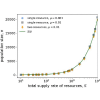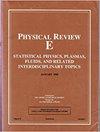研究进化救援的资源建模方法
IF 2.4
3区 物理与天体物理
Q1 Mathematics
引用次数: 0
摘要
在本文中,我们利用基于资源的建模方法对进化拯救的动态进行了深入研究。利用经典的消费者-资源模型,我们旨在了解物种如何适应改变可替代资源可用性的环境突变。通过分析解决方案和模拟技术,我们探索了种群从临界规模恢复并避免灭绝的条件。我们的研究结果强调了最小可行种群规模、突变率和代谢策略的适应能力在影响种群恢复能力方面的重要性。我们证明,虽然突变率的提高能使种群进化出适合已改变的资源环境的新的代谢策略,从而促进种群更快地恢复,但种群规模较小或面临资源可用性严重下降时更容易灭绝。这项研究为生态动力学和进化机制之间的相互作用提供了宝贵的见解,为预测种群的持续性和在不断变化的环境条件下制定保护策略提供了一个全面的框架。本文章由计算机程序翻译,如有差异,请以英文原文为准。

Resource-based modelling approach to studying evolutionary rescue
In this paper, we present an in-depth investigation into the dynamics of evolutionary rescue using a resource-based modelling approach. Utilizing classical consumer-resource models, we aim to understand how species can adapt to abrupt environmental changes that alter the availability of substitutable resources. Through both analytical solutions and simulation-based techniques, we explore the conditions under which populations can recover from critical sizes and avoid extinction. Our findings highlight the importance of minimum viable population sizes, mutation rates, and the adaptive capacity of metabolic strategies in influencing population resilience. We demonstrate that while increased mutation rates can facilitate faster recovery by enabling populations to evolve new metabolic strategies suited to the altered resource landscape, populations starting with smaller sizes or facing severe reductions in resource availability are more susceptible to extinction. This study offers valuable insights into the interplay between ecological dynamics and evolutionary mechanisms, providing a comprehensive framework for predicting population persistence and informing conservation strategies under changing environmental conditions.
求助全文
通过发布文献求助,成功后即可免费获取论文全文。
去求助
来源期刊

Physical review. E
物理-物理:流体与等离子体
CiteScore
4.60
自引率
16.70%
发文量
0
审稿时长
3.3 months
期刊介绍:
Physical Review E (PRE), broad and interdisciplinary in scope, focuses on collective phenomena of many-body systems, with statistical physics and nonlinear dynamics as the central themes of the journal. Physical Review E publishes recent developments in biological and soft matter physics including granular materials, colloids, complex fluids, liquid crystals, and polymers. The journal covers fluid dynamics and plasma physics and includes sections on computational and interdisciplinary physics, for example, complex networks.
 求助内容:
求助内容: 应助结果提醒方式:
应助结果提醒方式:


